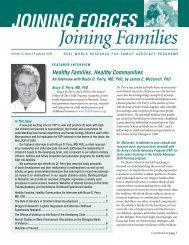stigma and barriers to care - Uniformed Services University of the ...
stigma and barriers to care - Uniformed Services University of the ...
stigma and barriers to care - Uniformed Services University of the ...
Create successful ePaper yourself
Turn your PDF publications into a flip-book with our unique Google optimized e-Paper software.
66<br />
Stigma <strong>and</strong> Barriers <strong>to</strong> Care — Caring for Those Exposed <strong>to</strong> War, Disaster <strong>and</strong> Terrorism<br />
mental illness are weak or dangerous.” Prejudice brings in an affective component. The<br />
third construct, discrimination, is a behavioral result.<br />
The o<strong>the</strong>r part <strong>of</strong> our model is types <strong>of</strong> <strong>stigma</strong>, which Bernice Pescosolido discussed<br />
earlier. Public <strong>stigma</strong> is what <strong>the</strong> public does <strong>to</strong> people with mental illness<br />
when we endorse <strong>stigma</strong> about <strong>the</strong>m. Self <strong>stigma</strong> is what people with mental illness<br />
do <strong>to</strong> <strong>the</strong>mselves if <strong>the</strong>y internalize <strong>the</strong> <strong>stigma</strong> <strong>the</strong>y receive. Structural <strong>stigma</strong> involves<br />
socioeconomic forces that result in laws, statutes, <strong>and</strong> unclear structures that keep a<br />
group down. The group we are interested in <strong>and</strong> <strong>the</strong> kind <strong>of</strong> <strong>stigma</strong> we are interested<br />
in at our center is what we have come <strong>to</strong> call label avoidance because it does not seem<br />
<strong>to</strong> fit under any o<strong>the</strong>r type.<br />
Label avoidance does not necessarily involve a person with mental illness. It is<br />
also not <strong>the</strong> concern <strong>of</strong> <strong>the</strong> public. It is <strong>the</strong> concern <strong>of</strong> a person who fears <strong>the</strong>re might<br />
be mental illness <strong>and</strong> in order <strong>to</strong> avoid that fear <strong>the</strong>y avoid <strong>the</strong> label. The best way <strong>to</strong><br />
avoid <strong>the</strong> label is <strong>to</strong> avoid all mental health pr<strong>of</strong>essionals because <strong>the</strong> easiest way <strong>to</strong><br />
get labeled is <strong>to</strong> be seen coming out <strong>of</strong> a psychiatrist’s <strong>of</strong>fice or have people learn that<br />
you are taking psychiatric drugs. We realize <strong>the</strong> reason people do not get treatment is<br />
<strong>to</strong> avoid <strong>the</strong> shame <strong>of</strong> serious mental illness, <strong>the</strong>refore avoiding discrimination.<br />
What is <strong>of</strong> particular concern is adherence. We have come <strong>to</strong> underst<strong>and</strong> adherence<br />
in two separate ways. Both might be a function <strong>of</strong> label avoidance. One is <strong>to</strong> not seek<br />
<strong>care</strong>. We looked at NCS <strong>and</strong> ECA (Epidemiologic Catchment Area) <strong>to</strong> get a sense <strong>of</strong><br />
<strong>the</strong> huge number <strong>of</strong> people who never seek <strong>care</strong> when <strong>the</strong>y are in need. The o<strong>the</strong>r way<br />
we underst<strong>and</strong> adherence is by looking at people who do seek out <strong>care</strong>, but who do<br />
not stay in treatment.<br />
In thinking about developing an anti-<strong>stigma</strong> program we have <strong>to</strong> be clear about<br />
what we are focusing on, which is people who are trying <strong>to</strong> avoid <strong>the</strong> label. We are<br />
looking at one small part <strong>of</strong> <strong>stigma</strong>. One <strong>of</strong> <strong>the</strong> important behaviors we are interested<br />
in is getting people <strong>to</strong> participate in treatment. One way <strong>to</strong> assess that is website use<br />
because all PSAs include websites with <strong>the</strong> hope that people will use <strong>the</strong>m for significant<br />
information <strong>and</strong> <strong>to</strong> get direct help for <strong>the</strong>ir problems.<br />
Our research group distinguishes between <strong>the</strong> processes <strong>and</strong> <strong>the</strong> vehicles <strong>of</strong> <strong>stigma</strong><br />
change, what an individual might do <strong>to</strong> change mental illness <strong>and</strong> <strong>the</strong> vehicles <strong>the</strong>y<br />
might employ <strong>to</strong> do so. There are three different processes for <strong>stigma</strong> change. Education<br />
is <strong>the</strong> one that readily comes <strong>to</strong> mind for most people: If we provide more information<br />
about mental illness, people are more likely <strong>to</strong> give up <strong>the</strong> myth. The second process,<br />
protest, is probably <strong>the</strong> way a Baptist minister would approach <strong>stigma</strong> change, “Shame<br />
on us for thinking that way. We should not pursue this kind <strong>of</strong> viewpoint anymore.”<br />
The third process is something that is still used, especially in school settings, <strong>and</strong> that<br />
is contact. I agree with what was said earlier—if you had <strong>to</strong> throw all your money at<br />
something, contact is <strong>the</strong> thing <strong>to</strong> look at.<br />
Education tends <strong>to</strong> be a comparison between <strong>the</strong> myths <strong>of</strong> mental illness <strong>and</strong> <strong>the</strong><br />
facts. For example, one <strong>of</strong> <strong>the</strong> myths <strong>of</strong> mental illness is that serious mental illness is<br />
rare. This is known as <strong>the</strong> “leprosy myth,” <strong>the</strong> idea that leprosy was this evil rare thing<br />
for which people were thrown out <strong>of</strong> <strong>the</strong> world. In reality we know that, depending<br />
on whose numbers <strong>and</strong> what epidemiologic study you are looking at, schizophrenia<br />
is about 0.8% <strong>of</strong> <strong>the</strong> population. That is difficult <strong>to</strong> get a h<strong>and</strong>le on until you realize<br />
that Chicago has about 64,000 people with schizophrenia. That is <strong>the</strong> same number<br />
<strong>of</strong> people who live in Joliet, Illinois. That is just people with schizophrenia. If you<br />
throw in bipolar disorder <strong>and</strong> significant psychotic depression, serious mental illness<br />
is common <strong>and</strong> frequent.




